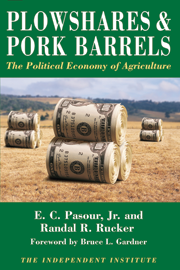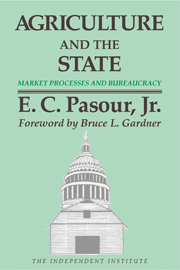The full long-run effects of any government program are never known in advance. To illustrate, consider U.S. farm policies.
A host of “emergency” agricultural programs were enacted by President Roosevelt during the Great Depression. Although the particulars of these programs have undergone numerous changes since then, the fundamental functions and impacts of many of them remain intact even though economic conditions bear little resemblance to those of the 1930s.
The New Deal programs have proven to be not only persistent, but also profligate and regressive. In recent years, more than half of all direct government farm payments have gone to the 10 percent of farms with incomes of $250,000 or more. This is not likely to change in the new farm bill. Farmers, if married, will be eligible for subsidies if their annual incomes are as high as $1.5 million. Perennial government aid to farmers with such income levels was not foreseen when farm programs were initiated!
The unforeseen consequences of U.S. farm policy may be even more important in programs for specific crops. For example, the price support program for sugar restricts imports and (in some recent years) domestic production. The program increases the domestic sugar price, often to levels more than double the world price.
When the sugar program began, who could have foreseen that a major corporation, Archer-Daniels-Midland Corporation (ADM), would become a major beneficiary? Although ADM does not produce sugar, it has reaped huge benefits from artificially high U.S. sugar prices, which increase demand for (and thus increase the price of) sugar substitutes. ADM is a major producer of high-fructose corn syrup, a widely used sugar substitute whose production became economical largely because of the price umbrella offered by the sugar program.
How can a program that benefits the few at the expense of the many survive in a democratic process? The sugar program concentrates benefits on a few thousand sugar beet producers and a much smaller number of cane growers and processors of sugar and sugar substitutes. The costs of the program are spread across all the rest of us, with the average consumer bearing an annual cost of less than $10. In contrast, a one-cent premium in sugar price has been estimated to benefit each sugar cane farm by $39,000. Over the last five years, the average U.S. sugar price has been about 10 cents per pound higher than the world price. Understandably, sugar producers and processors are much more active than consumers in periodic fights over sugar legislation. The sugar industry made political contributions of $3.3 million dollars during the 2006 election cycle.
The U.S. ethanol program is having an impact on U.S. agriculture that may be even more important than conventional farm programs. President Bush signed an energy bill in December 2007 mandating an increase in ethanol use from 4.7 billion gallons in 2007 to 36 billion gallons by 2022. Although the ethanol program was sold as a way to reduce dependence on imported oil and to decrease greenhouse emissions, it is increasingly viewed as a failure on both counts.
The loudest objections to the ethanol program, however, arise from the unforeseen impacts of increased ethanol production on food prices. This effect, which is now headline material throughout the world, is creating a backlash, the intensity of which is rarely seen in public policy.
U.S. corn prices have almost tripled, from roughly $2 per bushel in early 2006 to about $5.50 now, with the expanded production of ethanol being an important contributing factor. In early 2007, thousands of people marched in Mexico City to protest the rising cost of tortillas, which was blamed largely on increased U.S. ethanol production. Food riots have since erupted in countries all along the equator and some top international food scientists recently recommended halting the production and use of food-based biofuels, such as ethanol.
Environmentalists are belatedly recognizing other unanticipated effects of the ethanol program. These effects include decreased land for wildlife habitat as farmers put marginal land back into production, increased air pollution, and noxious odors and noise, as well as increased pressure on local water supplies.
Agricultural policy provides many examples of economic activity that would never be undertaken were it not for government subsidies and mandates. There is no escaping it—when government intervenes there will be unforeseen and unpredictable consequences.










